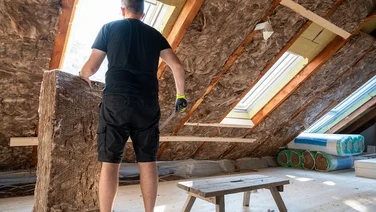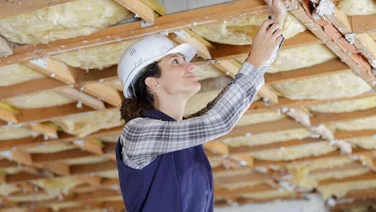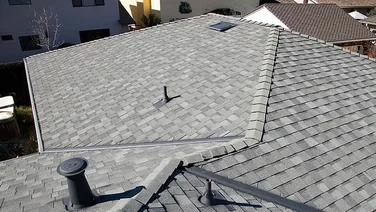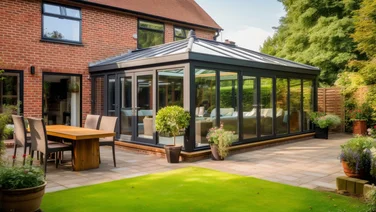- Cavity wall insulation costs around £2,700 for a three-bedroom, semi-detached property
- On average, cavity wall insulation will cost you £25–£65 per m²
- You can save around £210 per year on your energy bills
Cavity wall insulation costs between £1,000 and £4,600 to install, depending on the type of property.
This might sound expensive, but trust us when we say the benefits are definitely worth it.
With cavity wall insulation, you can save roughly 30% on your annual heating bill, which for a typical three-bedroom, semi-detached property, is around £210 (Energy Savings Trust, 2024).
This guide will cover everything you need to know about cavity wall insulation costs, including material and labour costs, when you’ll break even, and how to reduce what you spend.
If you’re ready to go ahead and install cavity wall insulation, we can help. Simply fill in this form with a few details about your home, and we’ll put you in touch with our trusted installers. They’ll get back to you with bespoke, obligation-free quotes for you to compare.
Get cavity wall insulation quotes
Answer a few quick questions, and our trusted installers will send you bespoke cavity wall insulation quotes – for free.

How much does cavity wall insulation cost in the UK?
On average, cavity wall insulation costs £30–£65 per square metre (m²), but this is just a general guideline. The best thing to do is to get a professional to properly estimate how much cavity wall insulation you need so you can get an accurate quote.
The rough cost to install cavity wall insulation throughout a typical three-bedroom, semi-detached property is £2,700.
This cost can fluctuate a fair bit though – for example, you might need to have previous cavity wall insulation removed, which will add to the total cost. As will the type of material used in the insulation.
How to work out what cavity wall insulation might cost you
One way to guess how much you might spend on cavity wall insulation is to do a rough calculation. Multiply a wall’s height and width in metres – this will give you the wall’s area in square metres. You can then estimate what it’d cost to fill the cavity by multiplying the rough cost of the material you choose (see below) with the total wall area.
For example:
A wall is 12m² and you’re using polystyrene builds for the insulation. Assuming an average cost per m² of £20, it’d cost you £240 to insulate this wall.
Breakdown of cavity wall insulation costs
The bulk of the cost of cavity wall insulation is in the materials used — the actual installation process only takes around two hours and makes up roughly 1% – 4% of the total price.
Below is a breakdown of the costs involved in more detail.
Material costs
The material used in your cavity wall insulation will greatly affect the total cost, so this is definitely worth considering. Generally speaking, mineral fibre insulation is the cheapest and most sustainable type of insulation material.
Spray foam insulation is the most expensive, and while it is an effective insulation material, it comes with a range of problems you should be aware of before you choose to use it.
| Material | Cost per m² (£) |
|---|---|
| Mineral fibre | 14–22 |
| Wool fibre | 25–30 |
| Polystyrene beads | 18–22 |
| Spray foam insulation | 30–65 |
Labour costs
Labour might not make up the bulk of installation costs, but there are still several factors to be aware of when installing cavity wall installation:
- Surveys and repairs
- Repairs
- Installing the insulation
Installing the insulation
This is the cheapest part of installing cavity wall insulation. For most of the UK, it’ll cost you between £15 and £20 per hour, with the majority of installations taking two–three hours. The price will likely be higher if you live in London (sometimes as much as double the cost).
The installation will usually only take one trained specialist to complete. Additionally, be aware that the installation price can increase by around £300 if you have a conservatory. This is because your installer will need to hire scaffolding to access the wall cavity.
Property survey
You’ll need to have your property assessed by a professional before you can go ahead and install cavity wall insulation. The process involves them inspecting your home to make sure your cavity walls are in good condition and can have insulation installed.
If there are no hurdles, the surveyor will discuss options with you (including what materials you’d like to use) and explain the process to you. You’ll likely be able to get cavity wall insulation if you meet some or all of the following criteria:
- Live in a home built between 1924 and 1982
- Have wall cavities that are at least two inches wide
- Your walls are in good condition
- There are no signs of damp on your interior or exterior walls
- Your property has good ventilation (or are able to install a vent)
- Your external walls can be easily accessed
Repairs
More often than not, you won’t repair cavity insulation so much as replace it completely. One thing to be aware of though, is something called a cavity wall tie. These are metal ties that connect the internal and external walls together.
If these cavity ties rust or break, it can lead to the wall sagging and potentially collapsing. A survey will identify whether you need these replaced or not, but if you do, it can be quite costly (particularly if the internal or external walls need to be rebuilt).
When will you break even on cavity-wall insulation?
You’ll break even on your cavity wall insulation in around five years, according to the Energy Saving Trust. This is based on the average annual savings of roughly £210 per year for a semi-detached, three-bedroom property, or roughly 30% off your annual heating bill.
Considering that cavity wall insulation can comfortably last 25 years or more, once you’ve broken even you’ll be in the green for years to come.
Additionally, cavity wall insulation can increase the value of your property, because it improves your Energy Performance Certificate (EPC) rating. Having a better EPC rating can also potentially improve your chance of selling your home by as much as 14%.
How to reduce cavity wall insulation costs
One of the best ways to reduce the cost of cavity wall insulation costs is to see if you’re eligible for one of several government insulation grants. If so, you might be able to cover 100% of the cost of cavity wall insulation.
If you live in the UK, you can see if you’re eligible for ECO4, which is the fourth and final stage of the government’s Energy Company Obligation scheme. This scheme requires large energy suppliers to support low-income, fuel-poor, and vulnerable households in making energy efficiency improvements to their homes.
With ECO4 you could get your cavity wall insulation entirely paid for, if you meet certain requirements.
People living in Wales have access to the Nest scheme, which was set up by the Welsh government to help improve the energy efficiency of homes in Wales. Like ECO4, it also covers cavity wall insulation improvements.
And in Scotland, there’s the Warmer Homes Scotland initiative, which provides eligible homes with funding worth £10,000 towards energy-efficiency improvements.
How much does it cost to remove or replace cavity wall insulation?
Removing cavity wall insulation costs around £22 per m², or approximately £2,100 for an entire property (according to Checkatrade).
Needing to remove your cavity wall insulation could be for various reasons, such as it no longer being as efficient due to age, or because of problems such as damp and mould.
Here are some other potential reasons for having your cavity wall insulation removed:
- Damage from either a floor or fire
- Vermin infestation
- Incorrect installation (which can lead to cold spots)
Thankfully, the removal process isn’t as complicated as it might sound. There’s no need for dismantling your walls — instead, a professional can vacuum it all out using specialised equipment.
Next steps
You’ve now got a pretty good idea of the costs involved in cavity wall insulation. Your next step now is to start searching for installers so you can get the benefits of keeping your home warmer and saving money on your energy bills.
If you’re ready to install cavity wall insulation, we can help you. Pop a few details about your home in this quick form, and we’ll connect you with trusted installers. They’ll get in touch with free cavity wall insulation quotes for you to compare.






